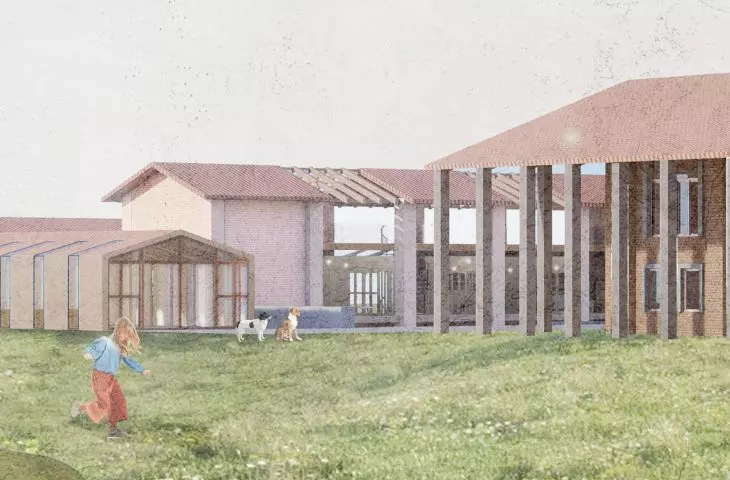In love with the Italian landscape and history, young architects Aleksandra Boszke, Maja Klawitter and Maciej Oprządek took part in the international Rural Housing competition. The challenge was to give new functions to traditional farm buildings located in the town of Sant'Alessio con Vialone. The team from Poland proposed modern agritourism and workshops, for which they received an honorable mention!
projection of the entire establishment
© Aleksandra Boszke, Maja Klawitter, Maciej Oprządek
new life of an Italian farm
The task of the competition, organized by the TerraViva Competitons platform, was to redesign and give new residential functions to the historic Cascina Lossano, a former farmhouse located in the Italian town of Sant'Alessio con Vialone, located between Pavia and Milan.
As the competition description reads, dating back to the 18th century, Cascina Lossano is part of a system of former rural agglomerations that are characteristic of this Italian region. The Cascina's buildings are organized around a central courtyard, following the typical pattern of a historic Lombard farm. Within this layout, two types of buildings can be distinguished: a manor house consisting of three levels and an adjacent single-story farmhouse.
There is a vineyard on the premises
© Aleksandra Boszke, Maja Klawitter, Maciej Oprządek
On the other side of Aia's main courtyard is a distinctive brick porch, which also dates back to the 18th century. All the buildings of the historic complex have a gabled roof made of wood and tiles. Currently, the complex is unused and slowly deteriorating, for this the organizers of the Rural Hausing competition, following the spirit of reuse, wanted to bring it back to life, giving it a new function, but preserving the original structure. Participants were asked to adapt and transform traditional structures into a new residential complex, using and recycling found materials.
The main building consists of three levels
© Aleksandra Boszke, Maja Klawitter, Maciej Oprządek
project from Poland awarded!
Submitted from all over the world, the works were evaluated by a jury consisting of: Simona Galateo (#S11), Philip Kolevsohn (ATOMAA), Virginia Theilig (FAPyD), Octavio Montestruque Bisso (ANDES), Coraly Mazzucchelli (ECKERSLEY O "CALLAGHAN), Danilo Sironi (One Works), Franca Carassai (CAMPBELL CADEY), Yuri Rocco (METROGRAMMA). Three grand prizes were awarded (First Prize to a team from Taiwan and Italy), four gold honorable mentions and ten honorable mentions. Among the distinguished works was a proposal from Poland — Away From the Hustle by a team consisting of Aleksandra Boszke, Maja Klawitter and Maciej Oprządek.
The awarded concept for the transformation of the property, located in the heart of the vineyard, is based on the use of existing farm buildings and the creation of a new agro-tourism complex.
By renovating and adapting these structures, using natural materials, we were able to create a harmonious, environmentally friendly place. It's a project that combines tradition with modernity, transforming old buildings into comfortable and luxurious apartments and common spaces," the authors explain.
design idea, sketches
© Aleksandra Boszke, Maja Klawitter, Maciej Oprządek
As they convince — every element of this establishment refers to nature. Inner courtyards, gardens, farmland and stone walls create a cozy atmosphere where guests can relax and fully immerse themselves in the beauty of the Italian landscape. Large windows in the apartments allow guests to enjoy the view of the surrounding vineyards and wheat fields.
However, it's not just the architecture that defines the place. Our agritourism concept emphasizes interaction with nature. Guests can walk through the vineyards, participate in the grape harvest, or tour the nearby fields, discovering the secrets of Italian agriculture. It's also an opportunity to sample local wines and dishes prepared with produce from their own gardens, the architects argue.
cross-section and division into functions
© Aleksandra Boszke, Maja Klawitter, Maciej Oprządek
reuse and memory of the past
The designers based the urban premise on a simple, harmonious approach that takes into account both the preservation of the historic character of the site and the creation of a modern community space. The central element is the road leading to Aia — the main courtyard. The authors focused on creating open spaces where people can meet and relax.
An open-air cinema on one of the facades of the foundation
© Aleksandra Boszke, Maja Klawitter, Maciej Oprządek
Wood, stone and brick are the three basic elements that define the aesthetics of the site and were originally used in the construction of the buildings. Wood was used to renovate the existing buildings, creating a warm and welcoming atmosphere. Stone elements, such as wall cladding, flooring and stairs, add solidity and character to the buildings. Brick, meanwhile, has been used on both the facades of the buildings and in the interiors, adding character and distinctiveness to the design.
The interior of the restaurant and bedrooms
© Aleksandra Boszke, Maja Klawitter, Maciej Oprządek
new passions
The main element of the establishment is the porch located in the center of Cascina Lossano, right next to the main courtyard. The architects decided to transform it into a space where agro-tourism guests spend time together and discover new passions. The eye is drawn to the large staircase, where visitors can sit. The facility's basement is dedicated to wine-making workshops, while the first floor is occupied by spacious rooms for yoga or pottery classes. The authors also proposed periodic cinema, art and culinary workshops, and outdoor concerts to foster integration.
The competition task was the revitalization of Cascina Lossano
© Aleksandra Boszke, Maja Klawitter, Maciej Oprządek
Cascina Lossano is not only a place for relaxation, it is also a story of transformation and rebirth. Our love of the region's history has resulted in a place that attracts lovers of tranquility, wine and Italian culture. It is an oasis where harmony with nature soothes the soul and inspires new discoveries," the authors conclude.










































